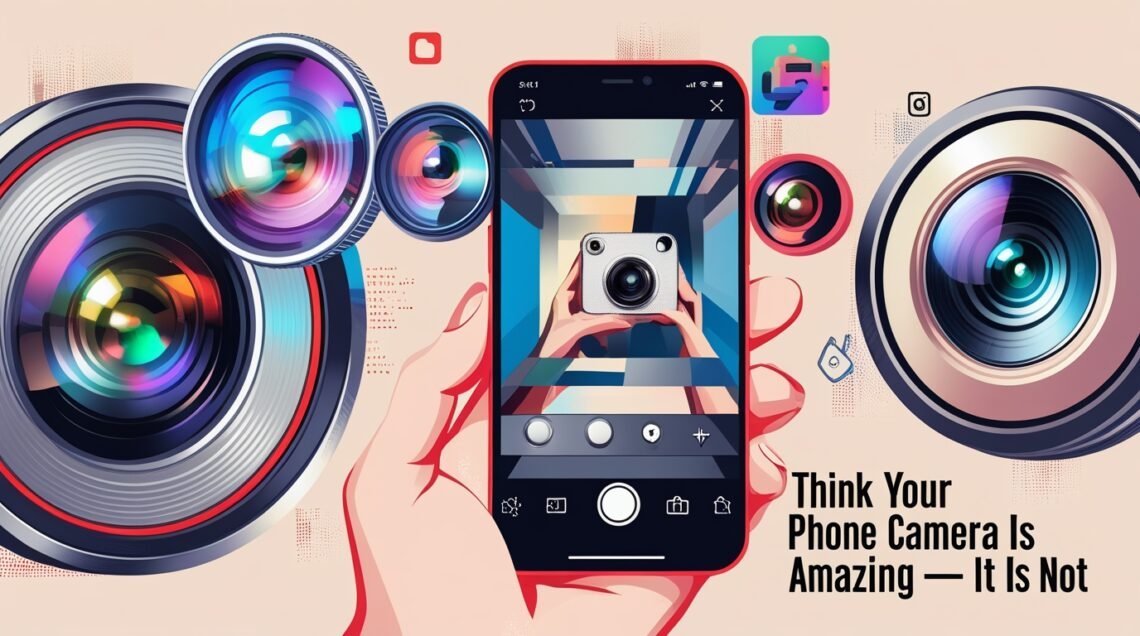Your phone camera might look impressive on the screen, but behind all the smart tricks, heavy processing, and fake detail, the truth is that it is hiding far more flaws than you think, and once you see how much it cheats to look good, you will never look at your photos the same way again.
The Evolution of the Phone Camera:
When the Visualphone VP210 hit the market in 1999, it advertised a never-before-seen feature: a camera. With only 0.11 megapixels and storage for 20 photos, the Visualphone is a relic compared to modern devices sporting three distinct cameras, each with up to 100 times more resolution. But while this technology has improved dramatically in the 21st century, engineers are rapidly approaching a hard limit on phone camera quality.
The Basics of a Digital Phone Camera:
To understand this limit, we first need to know how phone cameras work. Just like any other digital camera, when your phone takes a picture, light enters through its lens. This lens focuses the light onto an image sensor covered in a grid of photosites, microscopic light sensors roughly 100 times smaller than a grain of sand. There are millions of these sensors, and each one is covered by a red, green, or blue filter, allowing it to measure how much of that color is in the light hitting its location.
The Processor’s Role:
Then these measurements are simplified, rounding them to less detailed numbers. This step sacrifices some data, thus lowering the final images’ quality, but it’s essential for the camera’s processor. This computer can only handle so much information as it decrypts the three sets of color data to assemble a digital recreation of the image.
Metrics of Sensor Quality:
While the quality of this final photo depends on every part of the camera, nothing determines the look of a digital picture more than the image sensor. And engineers judge the quality of image sensors based on their performance in three areas. The first is resolution, or level of detail. Sensors with higher numbers of photosites offer better resolution, as the camera can collect more granular light data. The second and third are dynamic range and noise.
Dynamic range is the span from light to dark within a single photo, and noise is the graininess that can come from poor lighting, long exposure times, or an overheating camera. Both these factors can be improved by using larger photosites, which can capture more light overall. This wider range of data helps processors better measure the intensity of the incoming light, adding contrast and reducing noise.
Simply put, to make better digital cameras, you need image sensors with higher numbers of larger photosites. Engineers know this.
Why Phone Sensors are No Bigger than a Pea:
In fact, it’s basically how they’ve made the best cameras humanity has: giant telescopes that take photos of deep space. But phones don’t even have as much sensor space as a standard DSLR camera, let alone the surface area of a massive telescope. In fact, most phone camera sensors are no larger than a pea.
The Technological Trick:
Fortunately, these devices have a technological trick to compensate for their cameras’ tiny size: powerful processors. When you snap a picture on your phone, this pocket-computer starts running complex algorithms, which often begin by secretly taking a string of photos in rapid succession. The algorithms then manipulate these pictures, using math to perfectly align them and identify their best parts before combining the images into one high-quality photo. The end result is an image with less noise, wider dynamic range, and higher resolution than its sensors should be able to achieve.
Combining Photos with Algorithms:
This approach is known as computational photography, and advances here are likely how phone companies will continue to advertise increasingly better cameras without improving their image sensors.
The Future is Software:
Today, these algorithms often leverage machine learning, where phones learn to improve your shots based on patterns found in massive photo databases. For example, night mode prioritizes dynamic range and noise reduction, while portrait mode tells your phone to focus on a central subject and blur the background. Machine learning also allows our phones to do the opposite, unblurring faces to grab quick candid shots. And newer programs can even help you remove unwanted elements altogether.
Advanced Software Applications:
So, with the help of software, even phones with the smallest cameras can snap crisp, detailed photos of loved ones, spectacular views, and, of course, lots and lots of food.
Conclusion:
Phone cameras look impressive, but much of what you see is boosted by heavy processing, smart algorithms, and machine learning that work hard to hide tiny sensors and physical limits, and while the software magic is amazing, it also proves that your phone is not winning on pure camera power but on computational tricks that shape your photos into something your hardware could never capture on its own.
FAQs:
1. Why do phone photos look good even with small sensors?
Because advanced software fixes flaws and boosts detail.
2. What limits phone camera quality the most?
The tiny image sensor inside the phone.
3. Why do phone cameras use multiple lenses?
To compensate for the limited space and improve versatility.
4. What is computational photography?
A software method that blends and enhances images for better results.
5. Does more megapixels mean better photos?
Only if the sensor and light capture are strong enough.
6. Will phone cameras ever match real cameras?
Hardware limits make that unlikely, but software will keep getting better.
